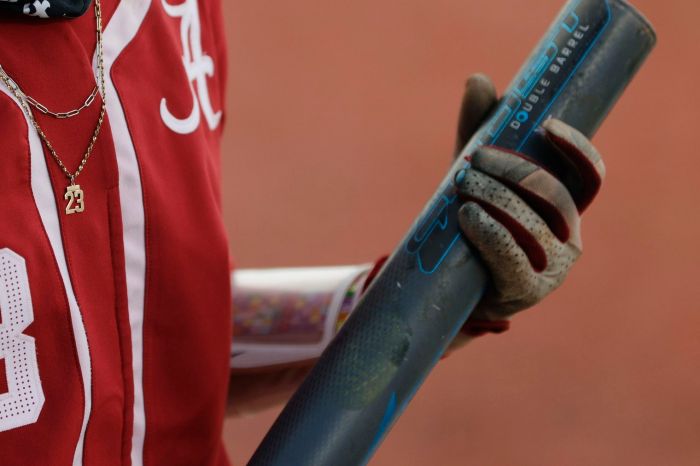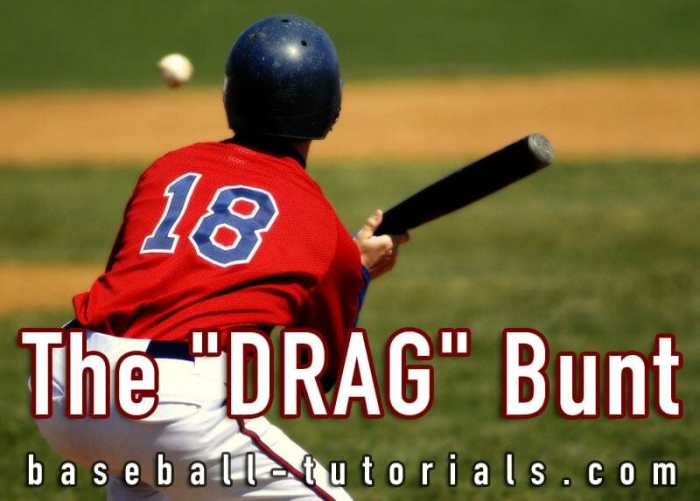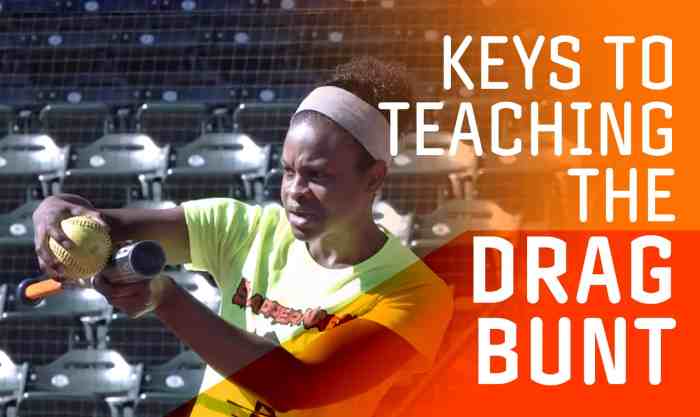Slap bunt vs drag bunt – Slap bunt vs. drag bunt: two distinct techniques in baseball that serve different purposes and require different executions. This comprehensive guide delves into the intricacies of each bunt type, exploring their similarities, differences, and strategic applications.
Whether you’re a seasoned baseball enthusiast or a curious newcomer, this analysis will provide valuable insights into the art of bunting, enhancing your understanding and appreciation for the game.
Overview

In baseball, a bunt is a strategic offensive play where the batter intentionally hits the ball softly, usually rolling it along the ground. There are two main types of bunts: the slap bunt and the drag bunt. Both techniques involve making contact with the ball and pushing it towards the infield, but they differ in their execution and intended outcomes.
Whether it’s a slap bunt or a drag bunt, both require precision and skill. Speaking of queens, have you heard about the “queen of the south oes”? Check out this article to learn more about this fascinating story. Getting back to slap bunts vs drag bunts, it’s all about timing and execution.
Slap Bunt
A slap bunt is executed by holding the bat loosely and making a quick, downward swing. The batter aims to hit the ball squarely on the barrel of the bat and impart a sharp, downward force to create backspin. The result is a low, line-drive bunt that travels quickly along the ground, making it difficult for the fielders to handle cleanly.
Drag Bunt
A drag bunt is performed by holding the bat more firmly and making a longer, sweeping motion. The batter aims to drag the bat across the ground, making contact with the ball at the end of the swing. This creates a slow, rolling bunt that travels along the infield at a slower pace.
Drag bunts are often used to sacrifice a runner to advance another base.
Execution

Executing a slap bunt and a drag bunt involves distinct techniques. Let’s delve into the steps and compare their differences:
Slap Bunt
- Position the bat perpendicular to the plate, with the knob slightly higher than the barrel.
- As the pitch approaches, quickly swing the bat down and across the ball, aiming to make contact with the bottom of the barrel.
- Squeeze the bat tightly and pull it back slightly after contact, imparting a topspin to the ball.
Drag Bunt
- Hold the bat at a 45-degree angle to the plate, with the barrel facing slightly upward.
- As the pitch arrives, drag the bat forward and downward, keeping the barrel in contact with the ball for as long as possible.
- Follow through by pushing the bat forward and slightly upward, lifting the ball off the ground.
Comparison of Techniques
While both bunts aim to advance the batter, their techniques differ significantly:
- Bat Angle:Slap bunts use a perpendicular bat angle, while drag bunts use a 45-degree angle.
- Contact Point:Slap bunts aim for the bottom of the barrel, while drag bunts contact the ball with the entire barrel.
- Swing Motion:Slap bunts involve a quick and downward swing, while drag bunts use a dragging motion.
Purpose: Slap Bunt Vs Drag Bunt

A bunt is a strategic play in baseball where the batter intentionally hits the ball softly, typically to advance a runner or runners on base. There are two main types of bunts: the slap bunt and the drag bunt. Each type of bunt serves a specific purpose and is most effective in different situations.
Slap Bunt
The slap bunt is designed to be hit sharply and quickly, typically with the bat held close to the body. The batter aims to make contact with the top of the ball, sending it on a low trajectory just beyond the reach of the pitcher.
The purpose of a slap bunt is to create a quick, hard-hit ground ball that forces the defense to make a quick play, increasing the chances of advancing the runner or runners on base.
Drag Bunt
The drag bunt, also known as a sacrifice bunt, is executed by dragging the bat across the plate, making contact with the bottom of the ball. The batter aims to hit the ball softly and slowly, creating a high-arcing pop-up that lands just in front of the plate.
The purpose of a drag bunt is to sacrifice the batter’s at-bat to advance the runner or runners on base. By giving up an out, the batter can move the runners into scoring position or bring them home.
Situations for Effectiveness
The effectiveness of a slap bunt or drag bunt depends on the specific situation and the team’s strategy. Generally, a slap bunt is most effective when the batter has a good eye and quick reflexes, allowing them to hit the ball sharply and quickly.
A drag bunt is most effective when the team needs to advance runners without sacrificing an out, particularly in late-inning situations with runners in scoring position.
Slap bunts and drag bunts are both effective ways to advance runners, but they require different techniques. While you’re learning about the differences between slap bunts and drag bunts, you may also be interested in learning about parts of a hat diagram . Whether you’re a baseball enthusiast or a fashion aficionado, understanding the intricacies of both hats and baseball techniques can enhance your knowledge and appreciation.
Strategy
Deciding between a slap bunt and a drag bunt involves several strategic considerations. The batter’s skill, the pitcher’s tendencies, and the game situation all influence the choice.
Slap bunts are more aggressive and risky than drag bunts, as they require a more precise swing. However, they also have a higher potential for success, as they can be hit with more power and accuracy. Drag bunts, on the other hand, are more difficult to field, but they are less likely to produce a base hit.
Factors to Consider, Slap bunt vs drag bunt
- The batter’s skill: A batter who is skilled at slapping the ball should use a slap bunt. A batter who is not as skilled at slapping the ball should use a drag bunt.
- The pitcher’s tendencies: A pitcher who throws a lot of fastballs is more likely to be vulnerable to a slap bunt. A pitcher who throws a lot of off-speed pitches is more likely to be vulnerable to a drag bunt.
- The game situation: A slap bunt is a good choice when the batter needs to get on base quickly, such as in a late-inning rally. A drag bunt is a good choice when the batter wants to sacrifice himself to move a runner over, such as in a bunt-and-run situation.
Examples
- A batter who is facing a pitcher who throws a lot of fastballs and who is skilled at slapping the ball should use a slap bunt.
- A batter who is facing a pitcher who throws a lot of off-speed pitches and who is not as skilled at slapping the ball should use a drag bunt.
- A batter who is in a late-inning rally and needs to get on base quickly should use a slap bunt.
- A batter who wants to sacrifice himself to move a runner over should use a drag bunt.
Pros and Cons

Both slap bunts and drag bunts have their own advantages and disadvantages. The following table compares the two types of bunts based on factors such as success rate, speed, and risk of injury.
Success Rate
Slap bunts are generally more difficult to execute than drag bunts, and therefore have a lower success rate. However, when executed properly, slap bunts can be very effective at getting on base. Drag bunts are easier to execute, but they are also less likely to result in a hit.
Speed
Slap bunts are faster than drag bunts, as they require less time to execute. This can be an advantage in situations where the runner needs to get on base quickly, such as with a runner on third base and less than two outs.
Risk of Injury
Slap bunts carry a higher risk of injury than drag bunts, as the batter is more likely to be hit by the pitch. However, the risk of injury is still relatively low for both types of bunts.
The slap bunt and drag bunt are two distinct techniques in baseball, each with its own advantages. While the slap bunt is more aggressive and typically results in a higher average, the drag bunt is more controlled and often used to advance runners.
The choice between the two depends on the situation and the player’s strengths. As the Bard once wrote in my words fly up hamlet , “There is a tide in the affairs of men, which, taken at the flood, leads on to fortune.”
In the same way, choosing the right bunting technique can lead to success on the baseball field.
Variations

Slap bunts and drag bunts have several variations, each with its own advantages and disadvantages.
Slap Bunts
- Traditional Slap Bunt:The batter swings down and across the ball, slapping it toward the third base line. This variation is effective for getting on base quickly, but it can be difficult to control the ball’s direction.
- Power Slap Bunt:The batter swings with more force than in the traditional slap bunt, hitting the ball harder and with more power. This variation can result in a longer hit, but it is more difficult to execute and can result in a groundout if not done correctly.
Drag Bunts
- Traditional Drag Bunt:The batter drags the bat along the ground, pushing the ball toward first base. This variation is the easiest to execute and provides good control over the ball’s direction, but it is slower than other bunting variations.
- Push Drag Bunt:The batter pushes the bat forward with more force than in the traditional drag bunt, resulting in a harder-hit ball. This variation is more difficult to execute, but it can result in a longer hit.
- Swing Drag Bunt:The batter swings the bat slightly as they drag it along the ground, giving the ball more spin and distance. This variation is the most difficult to execute, but it can result in the longest hit.
Examples

Famous examples of slap bunts include:
- Juan Pierre’s game-winning bunt in the 2003 World Series: Pierre’s bunt in the 11th inning of Game 4 helped the Florida Marlins defeat the New York Yankees.
- Ichiro Suzuki’s record-breaking 2,000th hit: Suzuki became the first Japanese player to reach 2,000 hits in Major League Baseball with a slap bunt in 2016.
Drag bunts are also effective and can have a significant impact on the game:
- Derek Jeter’s walk-off bunt in the 2001 World Series: Jeter’s bunt in the bottom of the 12th inning of Game 4 gave the New York Yankees a dramatic victory over the Arizona Diamondbacks.
- Michael Brantley’s game-tying bunt in the 2016 World Series: Brantley’s bunt in the 9th inning of Game 7 helped the Cleveland Indians tie the game against the Chicago Cubs.
The success or failure of a bunt depends on various factors, including the batter’s skill, the situation in the game, and the defense’s positioning.
FAQ Guide
What is the main difference between a slap bunt and a drag bunt?
A slap bunt is executed with a quick, downward motion of the bat, while a drag bunt involves dragging the bat along the ground.
Which bunt type is more successful?
The success rate of each bunt type depends on the situation and the batter’s skill. However, slap bunts generally have a higher success rate due to their speed and unpredictability.
When should a batter use a slap bunt?
A slap bunt is most effective when the batter needs to reach base quickly, such as with runners on base or in a sacrifice situation.